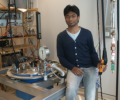 In this thesis the shrinking down of hardware feature sizes is the central base for research.
In this thesis the shrinking down of hardware feature sizes is the central base for research.
‘This can lead to packing densities beyond the scope of human design,’ Celestine Lawrence says. ‘Going beyond current CMOS technology, however, involves imperfections and other unintended physical effects. Inspired by natural evolution, we look for novel physical processes to be exploitable for computation.’
Instead of making circuits of functional units that have design rules to exclude unwanted physical processes - such as capacitive crosstalk - Celestine chooses a different, unconventional, route. ‘It’s more natural, I believe, to use matter in its design-less form,’ he says. ‘In this thesis research we showed that electronic properties of nanomaterial clusters can be evolved, to realize Boolean logic gates. The clusters are design-less, as they represent disordered assemblies of particles.’
Celestine’s work is part of the European NASCENCE program: NAnoSCale Engineering for Novel Computation using Evolution. ‘Fundamental research is still needed,’ Celestine says. ‘We performed experimental work. Clusters of nanoparticles were tested at 300 mK. We discovered that our system meets the essential criteria for the physical realization of neural networks: universality, compactness, robustness and evolvability. The same was repeated for clusters of dopant atoms at 77 K.’
For future functionality, such as image recognition, a large-scale small-world architecture was designed that interconnected several nanomaterial clusters by electronic switches whose configuration was to be evolved by a computer server.
Fabrication
‘As a PhD I was a member of two groups: Nanoelectronics and Formal Methods & Tools,’ Celestine says. ‘In most experiments nanoelectronics was central, which we performed in our own lab. We used Cleanroom facilities to fabricate the experimental chips. I enjoyed the workshops, learning a lot on how chips are actually designed and fabricated. Collaborating with post-docs and technicians within Mesa+ meant a lot to me and my research. While trusting the fabrication to these experts, I was able to concentrate on developing innovative algorithms and on scaling-up ideas, to interconnect several nanoscale clusters.’
SET network
‘We modelled the nanocluster material system, as a single-electron tunnelling (SET) network,’ he says. ‘We found in simulations that the system is evolvable to realize inhibition, which is an important neural network property. For simulations of large-scale SET networks, we developed a novel mean-field approximation and compared its accuracy with a standard Monte Carlo method, showing the system to be deterministic in principle.’
A large-scale SET network realizing brain-like functionality has not been realized yet. In exploring this exciting field of research, Celestine started with mathematically defining intelligence as the capacity to relate patterns to data. ‘Hence, we can measure the IQ of a physical system such as a SET network and have a quick estimate about the abundance and evolvability of its functionality, for tasks like Boolean logic and pattern recognition,’ he explains.
Human-like computing
Celestine hopes his work will contribute to make future computer generations ‘more human’. Deep learning machines have recently achieved superhuman skills, in playing strategic board games and video games, and have brought new knowledge and intuition to play these games.
‘But we are still a moon-shot away from achieving what is known as artificial general intelligence,’ Celestine says. ‘The challenge is to include empathy and wisdom, to make decisions between good and evil in the real world. In my opinion, it is a natural step for a design-less hardware revolution to follow soon after the design-less software revolution, enabled by Deep learning, has reached its limits.’
Writing
During his PhD Celestine learnt to find a good balance between writing and developing his research knowledge.
‘After a few years I found to choose good moments, alternating between writing and experimenting,’ he says. ‘By writing you take a healthy distance and reflection on the complex work, placing the concepts and its implication into context. Only when really understanding your work and results, one is able to explain it to a broader audience. This, in turn, helps me on thinking about developing strategies and future research planning.’
Future plans
After his PhD, Celestine plans to go and work in his birthplace Chennai, preferably at the Indian Institute of Technology Madras.
Celestine: ‘I would like to pursue a career in research, as I am very motivated to work on this type of unconventional, computation strategies further. I hope to find room for research on natural computation in India, working on faster nanoclusters and on electronic systems using these.’
